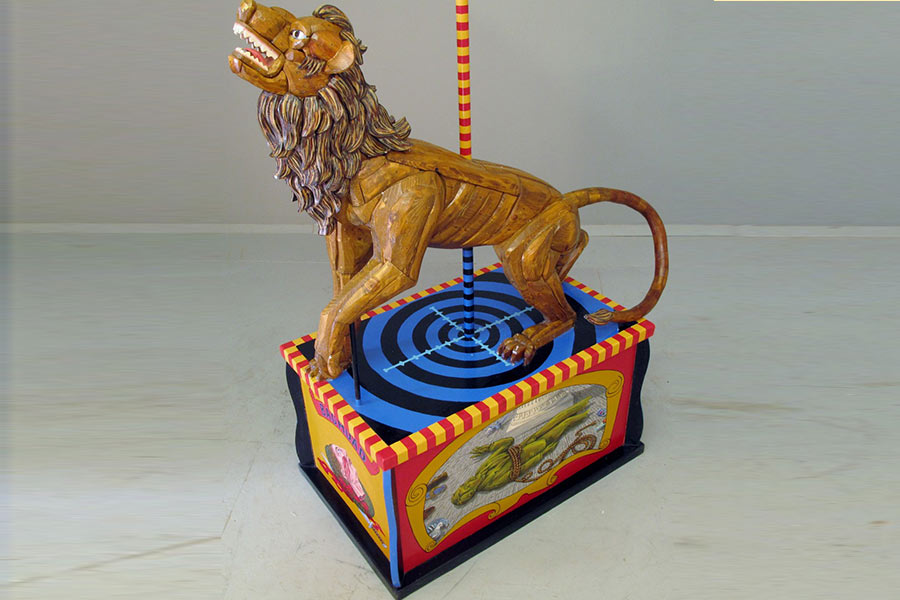Art lovers who enjoy beautiful imagery mixed with thought-provoking politics will welcome “M.A.D. (Mutual Assured Destruction),” a retrospective exhibit of larger-than-life sculptures and working drawings by H.D. Ivey, a local artist, activist and openly gay man.
The exhibit, which focuses on work that Ivey created in response to nuclear proliferation, was organized by Casa de Duende in partnership with Physicians for Social Responsibility. It is on display at Crane Arts, 1400 N. American St., through July 30.
In addition, Dr. Ira Helfand, a noted expert on nuclear weapons, will speak at the gallery on July 20. That lecture is free and open to the public.
According to David Acosta, cofounder of Casa de Duende, Ivey’s work represents a life-long engagement with socially relevant issues. For nearly five decades, Ivey has created artwork that addresses pressing social problems like censorship and HIV/AIDS, but nuclear proliferation is the subject he has returned to repeatedly.
Ivey’s commitment to political issues fits well with Casa de Duende’s mission, Acosta noted, but he pointed out that Ivey is more than just a social critic.
“Outside of the fact that it’s socially engaged and political art, it’s also really beautiful work,” he said.
Ivey, a native of Texas who came to Philadelphia in the mid-1980s, is modest about his work.
“I’m a political activist and I’m an artist, but I don’t have any illusions that the sculpture is going to change the world in and of itself,” he added.
Growing up during the Cold War, Ivey remembers “duck-and-cover” exercises at school and the nuclear brinkmanship that led to the Cuban Missile Crisis. Early on, he recognized the inherent madness of the nuclear-arms race; it’s been a consistent theme in his work ever since.
For this show, Ivey selected roughly 15 pieces, including “Baghdad,” a large figure of a lion, and “Zero,” a work about ground zero — a concept, he noted, that did not even exist until nuclear weapons were developed.
Ivey’s sculpture, made from wood, cast resin and metal, employs splashes of vibrant color and occasionally playful imagery. But the most consistent feature of his work is its large scale.
“I’m dealing with a subject matter of, kind of, megalomaniacal imperialism, so I’m building on that scale,” Ivey said. When depicting missiles, for example, making them big enables audiences to envision them as weapons rather than toys.
Although these sculptures may look huge within the confines of a gallery, they don’t seem that way to Ivey, who used to make enormous outdoor sculptures from steel.
“So when you say the work is large now, it doesn’t quite seem that way to me,” he said with a chuckle.
Still, if Ivey’s work seems to loom over viewers, that’s partly because we live in a world where impending nuclear annihilation is a possibility. That’s a sobering thought, but the sculptor takes pains to avoid plunging viewers into despair.
“It’s important to me for the images to move people but not to paralyze them with fear in the process,” he said.
To help alleviate viewers’ anxiety, Ivey tries to incorporate a sense of playfulness into his artwork.
“I have one sort of golden rule for myself when I make sculpture, which is that it has to be a fun process for myself,” he explained. “And I think if I work that way, then it makes it more likely that it’ll be fun for the viewer. So even though the subject matter is sometimes grim, the objects themselves are sometimes playful and light.”
That playfulness is evident in “Pistol Pete,” the oldest piece on exhibit. The sculpture is Ivey’s artistic response to former president Ronald Reagan’s Strategic Defense Initiative, commonly known as “Star Wars.” Standing over 9-feet tall, this sinewy, bare-chested figure wears a huge cowboy hat and has a gun for a phallus. It is simultaneously menacing and silly. It’s also serious: The sculpture draws parallels between the cowboy archetype, an enduring American myth, and imperialist expansion.
An ancillary theme running throughout the show is the sheer cost of nuclear proliferation. Every penny spent on weapons is money diverted from the public. This idea is most explicit in “Money,” but it recurs in multiple works.
“I think one of the central facts of the Cold War period, and this is true for the Soviets as well as for us, is that we spent our national treasures on our worst fears and failed to invest in our best selves,” Ivey said bluntly.
Today, America and the former Soviet Union are no longer the principal rivals in an unending arms race. In fact, more countries now have nuclear weapons already or are working on acquiring them.
Despite that dispiriting situation, Ivey hasn’t lost hope. When asked to put his art in perspective, he refers to the late historian Howard Zinn’s final book, “The Bomb.”
“He made the observation that small acts of conscience can change the world. So that’s really what I’m trying to do, just a small act of conscience in the hopes that it might make a difference.”
To learn more, visit www.casadeduende.com.

